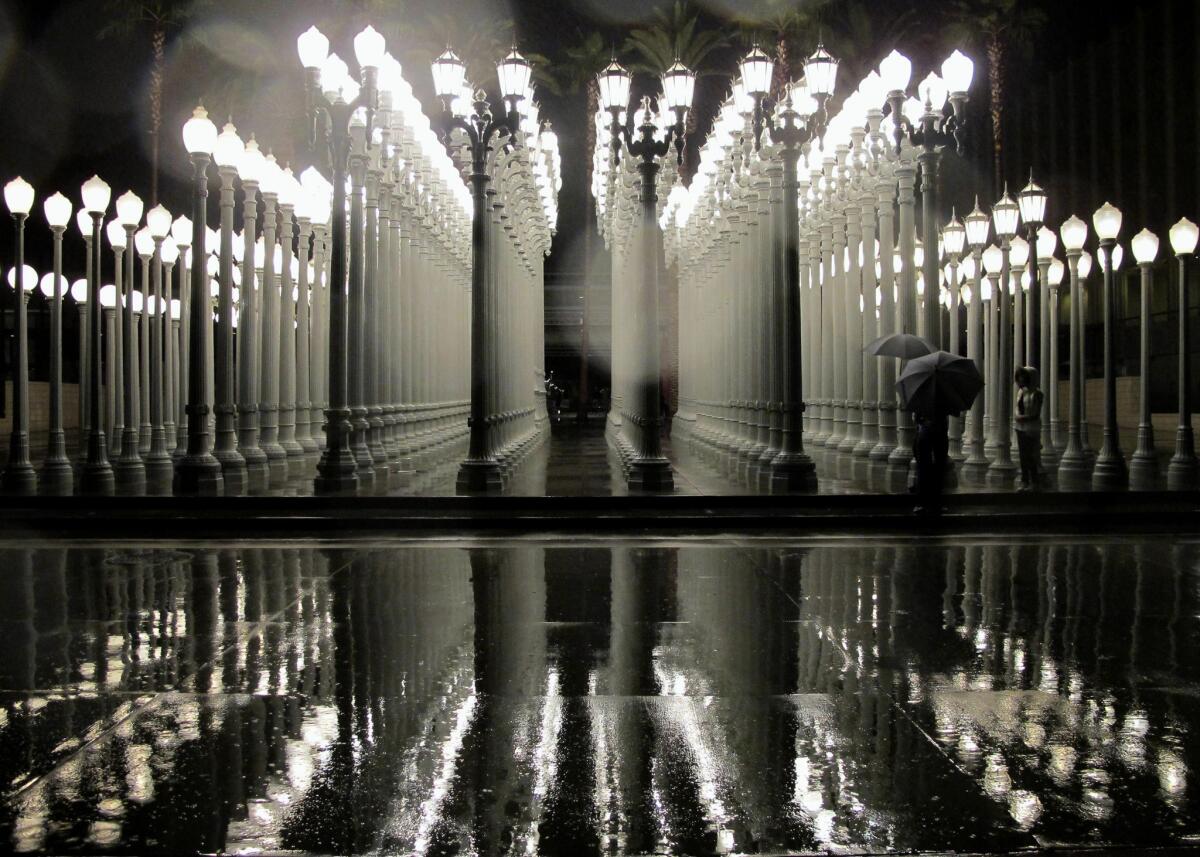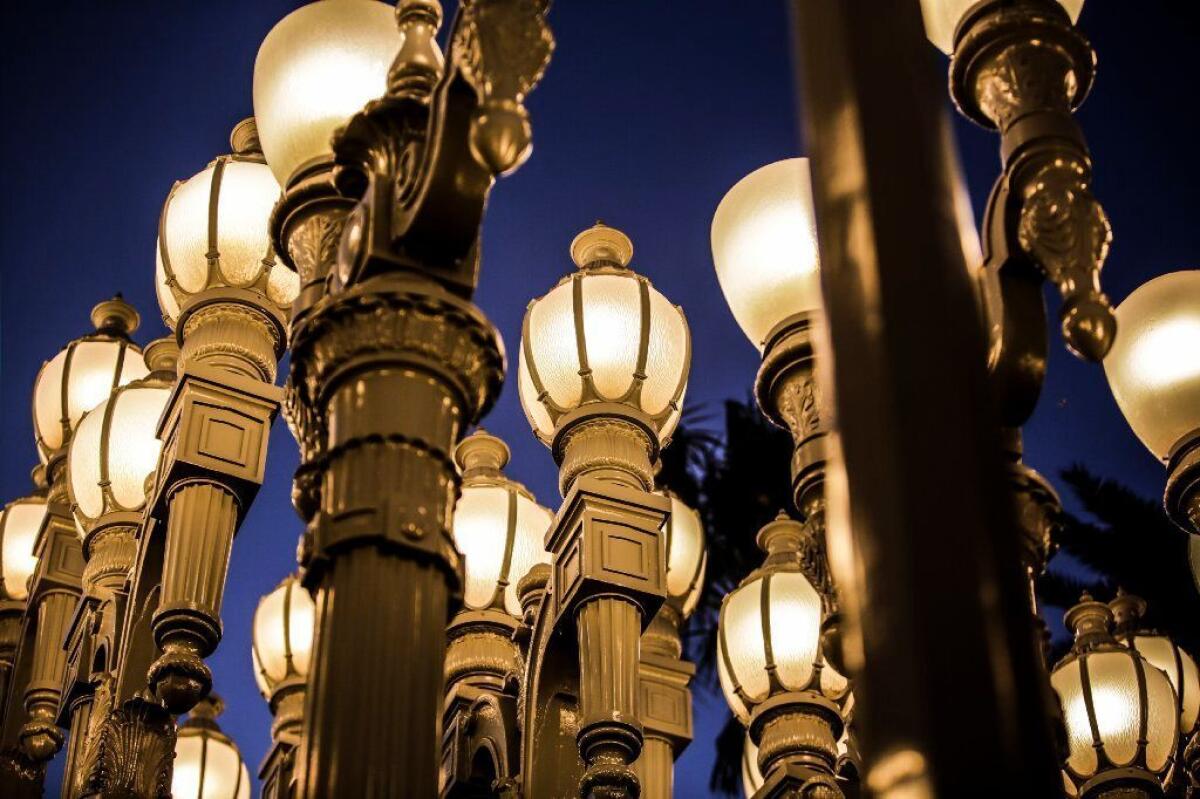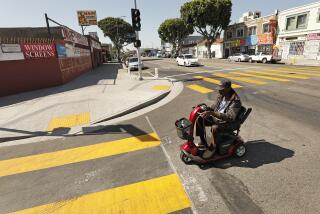Los Angeles is trying to create the perfect streetlamp — and right inequities as well

- Share via
In a city of celebrities, dramatic vistas and bold architecture, one of Los Angeles’ most photographed spots is an unassuming collection of 200 historic streetlights sitting in front of the Los Angeles County Museum of Art.
Lolis Galván, a special events photographer, routinely drives out to the installation, with her quinceañera clients in tow. On a recent Monday afternoon, she had a teenager clad in a turquoise ball gown and tiara gently lean into one of the streetlights that make up the sculpture.
“This is a place whose architecture captures the eye, that looks great day or night,” Galván said.
The “Urban Light” installation helped establish the old-fashioned streetlamp as an iconic object of modern Los Angeles. But there is a big difference between the ornate globes, formal columns and elegant curves of the streetlights on display and the utilitarian lighting that graces most streets in the city. Some streets have kept their old historic lamps or gotten replica versions, but they tend to be in more affluent areas.

Los Angeles officials are now trying to change that.
The city has launched a design contest for a new streetlight, one that places a premium on high design and great accessibility. Officials want a new design that better keeps with L.A.’s grand lighting past while also bringing such lights into a more diverse array of neighborhoods.
“We’re the design capital of the world,” said Los Angeles Mayor Eric Garcetti. “We should be able to showcase that design brilliance on our city’s streets. It shouldn’t just be something locked away in private companies. It should be where we walk home, where we walk to school, where we wait for the bus, on the streets that we drive through.”
The divide between ornamental streetlight haves and have nots is, in part, rooted in policy.
Back in 1925, the city created the Bureau of Street Lighting to provide power and maintenance for streetlights funded by developers. During that period, the contest’s webpage indicates, Los Angeles also began to install “a basic, utilitarian streetlight, frequently made up of a simple lamp attached to a timber pole.”
As a result, wrote historian and preservation architect Daniel Prosser in a survey for the city, less-affluent regions of Los Angeles came to have “a sparser and less attractive system of street lighting than the better-off neighborhoods.” The streetlight contest, said Christopher Hawthorne, chief design officer of the city of Los Angeles, aims to address this discrepancy.
Los Angeles has 223,000 streetlights, but only a fraction are of the high-style variety. Hawthorne said the fact that the LACMA installation has become such a sensation speaks to the potential of finding the perfect streetlamp.
“People have established such a strong emotional and nostalgic connection to those historic designs, which, in a way, is surprising because they’re just streetlights for a utilitarian purpose,” he said. “But I think people are very sensitive to the design of the objects that surround them, and when designers have taken care to make them thoughtful, make them beautiful, that has an impact.”
Residential communities such as Bel-Air, Hancock Park, Silver Lake, Westwood and Holmby Hills have some of the city’s most distinctive streetlamps. The distribution is more equitable in commercial districts. Downtown L.A. also has a wide variety of older models, including some that date back a century. Miles of Wilshire Boulevard and Olympic Boulevard west of downtown are lined with historic designs. Other streets like Hollywood Boulevard have replica versions of old designs.
The competition — the first in the city’s history — also speaks to a mounting pivot away from Los Angeles’ car culture. Its sponsors, who describe the ubiquitous cobra-head streetlight as a “skinny unadorned pole holding a curved horizontal arm,” maintain that this design is in “service solely of the automotive realm.”
Instead, the new lights are supposed to illuminate both the street and the sidewalk, in a nod to pedestrians. This is part of a larger trend in the city over the last decade to add lamps that face the sidewalk.
“We moved to the standard streetlight design that we use now after World War II,” added Hawthorne, a former Times architecture critic. “That was at the same moment that we were really expanding our freeways and our access for private motorists across the city. In effect, we were redesigning the city with drivers and cars in mind. Now we’re trying to rebalance that design strategy so that we’re also paying attention to people who are moving around the city in other ways. And rebalancing that space requires thinking about elements in the public realm, like streetlights, in a new way.”
Designing a new streetlight for Los Angeles, sponsors underscore, will be a tall order. Professional category applicants are encouraged to form teams with experts in industrial design, lighting design and engineering, as well as licensed architects. In addition to a lamppost, entries must include two fixtures, including one to illuminate pedestrian pathways. Entries must also incorporate a light-emitting diode strip, as well as hardware to hold devices that produce or extend shade.
On top of this, the new streetlights are required to feature “cultural placards,” on which the city will post poetry and references to nearby landmarks and community histories. Other suggested features include hardware that will enable streetlights to manage items such as solar panels, air quality and real-time traffic monitors, electric vehicle charging stations and 4G and 5G antennas. Contestants are also asked to use sustainable material to reduce the streetlight’s environmental impact and consider the welfare of the city’s wildlife — all this while maintaining an “elegant profile.”
“Good design is not a luxury,” said Hawthorne. “It’s not something we should have to pay a premium for. In fact, if we are careful about the things that we’re producing across the city, we can find some real efficiency there.”
Still, the question of cost is significant. The plan is for city officials to pick a new streetlight from the entries they receive. That lamp would then become the standard, to be used when lights need replacing or new developments come in. Currently, the city installs or replaces about 1,500 streetlamps every year. According to the mayor’s office, each current standard streetlight costs between $3,000 and $4,000. When asked how much it would cost to install or replace old streetlights with the new design, spokesperson Harrison Wollman said that the city “won’t know until the design is picked.” However, he added, “we’ve structured the competition so that it will include a rigorous technical review to make sure that the design we choose can be produced in a cost-effective manner.”
Los Angeles must also abide by Proposition 218, which dictates that property owners must vote before a city can impose new or increased assessments for streetlight repairs and installation. Such a vote, said Wollman, “is required only when we add a new pole to a street that doesn’t have one. The new streetlights will primarily replace ones in need of replacement, but we may potentially need a Prop. 218 process if we need to add a new pole to a street without one.”
Catherine Hernández, an affordable-housing advocate who grew up and remains rooted in South-Central Los Angeles, said it is essential for the city to think critically about where the new streetlights will be distributed.
“We have a very inequitable city,” she said. “And when we see an improvement that comes from the city, it usually goes to neighborhoods that don’t need it. Streets like the one where I grew up — which was marked by gang activity, violence, car abandonment and vacant lots — tend to be dimly lit.”
Moving forward, Hernández proposed being strategic about transforming areas subject to blight. Officials, perhaps, could install new streetlights in alleys that connect the larger streets of South-Central Los Angeles. The running path at Evergreen Cemetery in Boyle Heights, she said, serves as an example. Once dark and uninviting, the path is now teeming with joggers.
Mayor Garcetti echoed Hernández’s points, casting light as an equity issue, much as he’s done with shade. Light, he added, “drives economic opportunity, public safety, and social connectivity.” His hope is that a new, widespread streetlight design can aid in getting more Angelenos out on the streets, enabling them to get to know their city, and their neighbors, a little better.
“So much of Los Angeles is eclectic and beautifully diverse in its design,” Garcetti said, “but we also have few things that unite us.”
More to Read
Sign up for Essential California
The most important California stories and recommendations in your inbox every morning.
You may occasionally receive promotional content from the Los Angeles Times.











